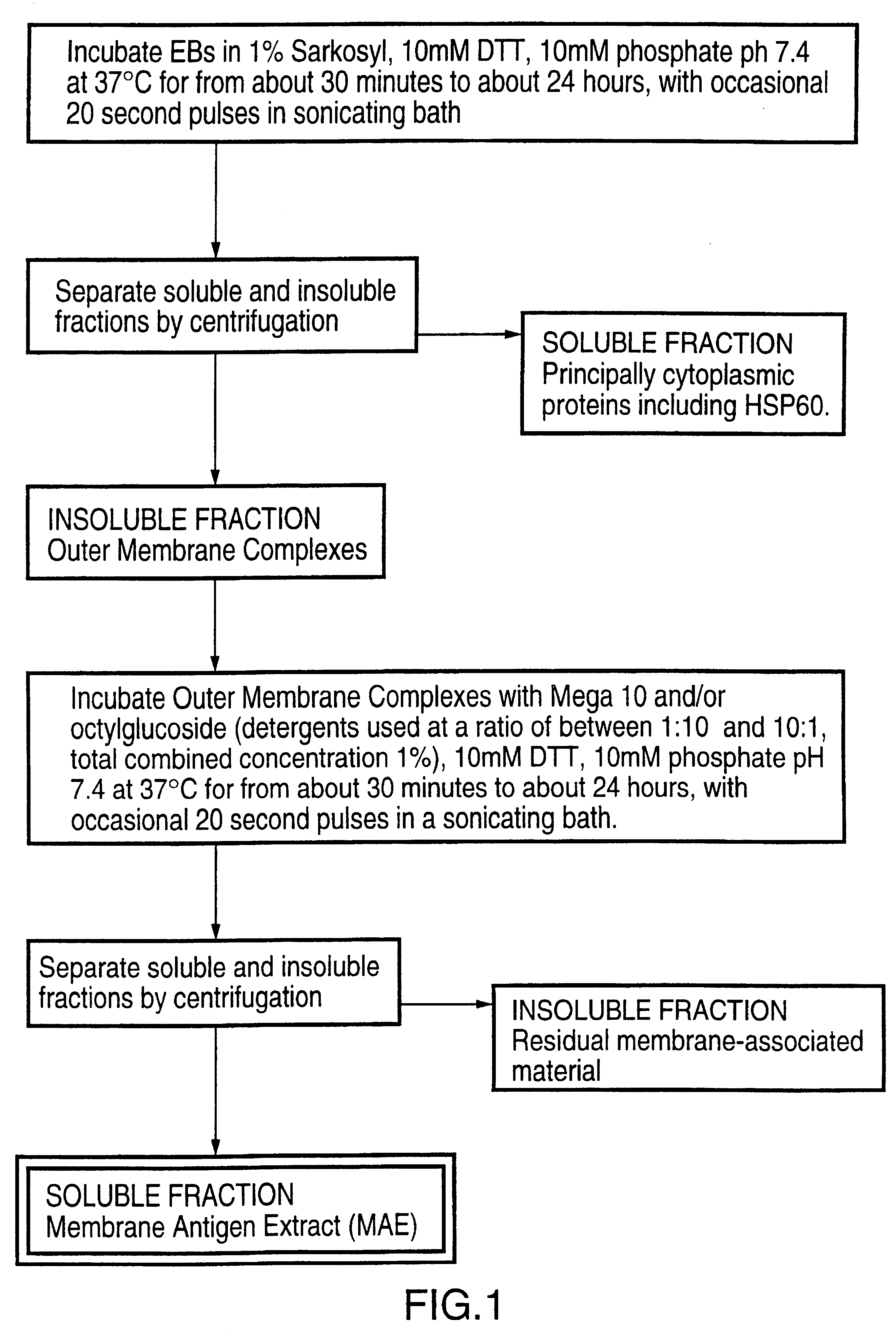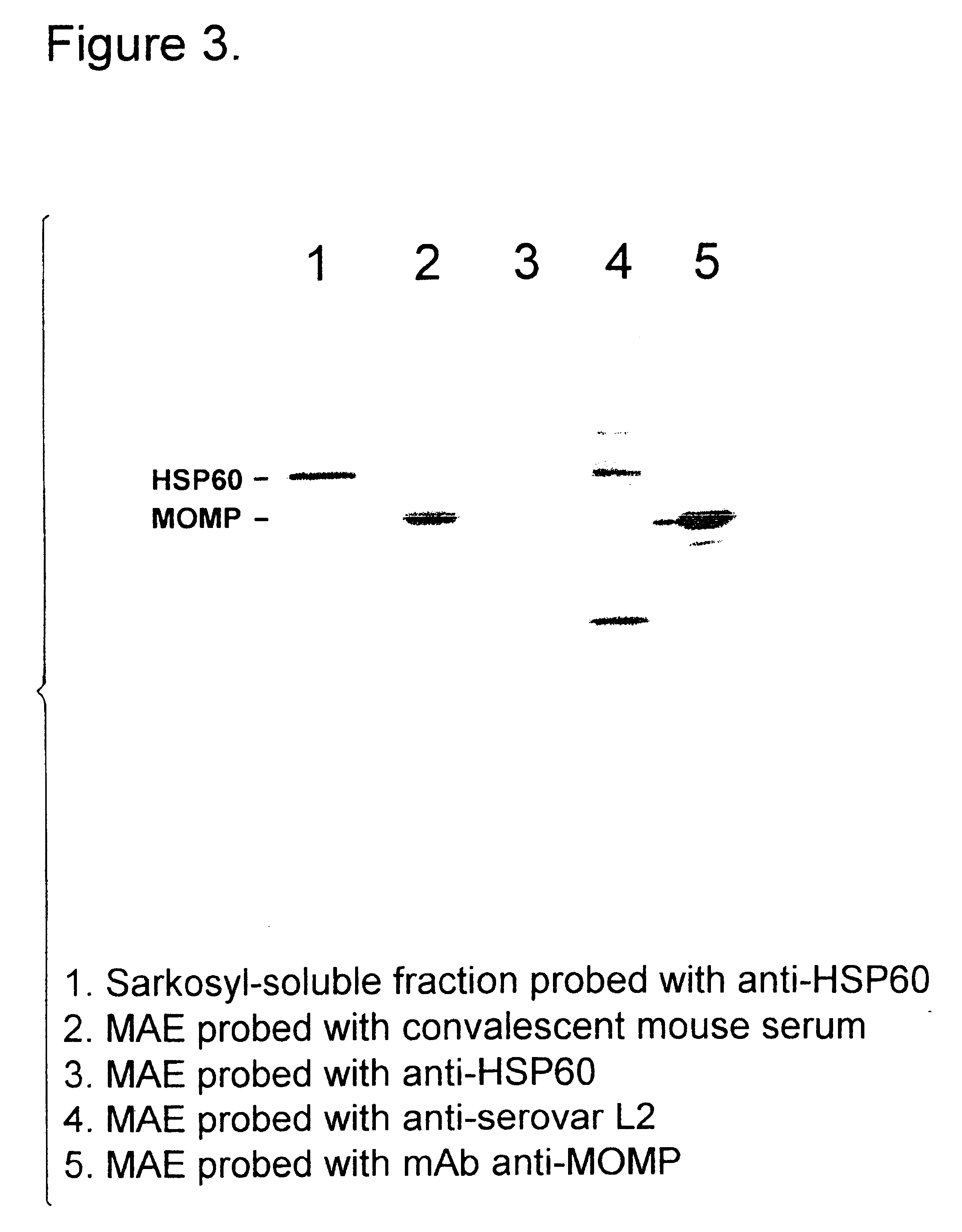Chlamydial vaccines and immunogenic compositions containing an outer membrane antigen and methods of preparation thereof
a technology of outer membrane and antigen, which is applied in the field of chlamydia trachomatis, can solve the problems of serious disease, chlamydial infection common inflammation, and poor inducer of mucosal immunity by conventionally administered subunit immunogens, and achieve the effect of reducing background
- Summary
- Abstract
- Description
- Claims
- Application Information
AI Technical Summary
Benefits of technology
Problems solved by technology
Method used
Image
Examples
example 1
This Example illustrates the preparation of the membrane antigen extract from chlamydial elementary bodies, as shown in FIG. 1.
Purified elementary bodies (EBs), prepared as described in ref. 19, were resuspended in 10 mM phosphate buffer, pH 7.4, and made to 1 wt % Sarkosyl (N-Lauylsarosine, sodium salt), 10 mM DTT. The EBs were incubated at 37.degree. C. for about 90 minutes, with occasional 20 second pulses in a sonicating water bath. Following the incubation, soluble and insoluble fractions were separated by centrifugation at 150,000 g for 1 hour at 20.degree. C. The insoluble fraction comprises outer membrane complexes which are recovered as a pellet, while soluble material comprising principally cytoplasmic proteins including HSP60, remains in the supernatant. The insoluble fraction was resuspended in 10 mM phosphate buffer, pH 7.4, containing 10 mM DTT, and decanoyl-N-methylglucamide (Mega 10) and / or octyl glucoside at a total combined concentration of about 1 wt %. The resusp...
example 2
This Example illustrates the preparation of ISCOMs with the membrane antigen extract according to the methods of Morein (ref. 36) or of Mowat and Reid (ref. 37).
When following the method of Morein, ISCOMs were prepared by diluting the MAE, prepared as described in Example 1, to about 0.2 mg / ml with 10 mM phosphate buffer pH 6.8. Phosphatidyl choline and cholesterol were dissolved at about 5 mg / ml each in approximately 20% Mega 10 and then added to the diluted MAE to a final concentration of 0.2 mg / ml each. Quil A (a complex but purified mixture of Quillaja saponins which are glycosides of quillaic acid and carbohydrates) was added to a concentration of about 1 mg / ml. Sufficient 20% Mega 10 was then added to bring the final concentration in the mixture to about 1%wt. The mixture was shaken at room temperature overnight and then dialysed at 20 to 25.degree. C. against three changes of 10 mM phosphate buffer, pH 6.8, for about 6 hours, about 16 hours and about 6 hours for the three buf...
example 3
This Example illustrates the immunogenicity of chlamydial membrane antigen extract (MAE)-ISCOMs in mice.
Female A / J mice were immunized with MAE-ISCOMs, prepared as described in Example 2 following the procedure of Mowat and Reid, containing about 0.25 .mu.g of protein by the intraperitoneal (mice #63-64) or the intranasal (mice #65-68) routes on days 1 and 14, or with MAE containing about 1 .mu.g of protein in complete Freund's adjuvant on day 1 and with MAE containing about 1 .mu.g of protein in incomplete Freund's adjuvant on day 14 (mice #9-12). Sera and vaginal washes were taken on days 0 and 28, and assayed in an ELISA assay for MAE-specific serum IgG, serum IgA, vaginal IgG and vaginal IgA.
As may be seen from the results obtained (FIG. 6), the MAE-ISCOMs provided herein induced serum IgG titres comparable to those induced by the higher dose of MAE in Freund's (upper panels), and consistently induced vaginal IgG (penultimate panels). MAE in Freund's adjuvant did not induce any ...
PUM
| Property | Measurement | Unit |
|---|---|---|
| mass | aaaaa | aaaaa |
| molecular weight | aaaaa | aaaaa |
| molecular weights | aaaaa | aaaaa |
Abstract
Description
Claims
Application Information
 Login to View More
Login to View More - R&D
- Intellectual Property
- Life Sciences
- Materials
- Tech Scout
- Unparalleled Data Quality
- Higher Quality Content
- 60% Fewer Hallucinations
Browse by: Latest US Patents, China's latest patents, Technical Efficacy Thesaurus, Application Domain, Technology Topic, Popular Technical Reports.
© 2025 PatSnap. All rights reserved.Legal|Privacy policy|Modern Slavery Act Transparency Statement|Sitemap|About US| Contact US: help@patsnap.com



